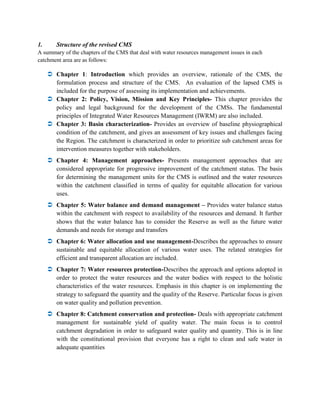
Revised CMS Structure and Chapters
- 1. 1. Structure of the revised CMS A summary of the chapters of the CMS that deal with water resources management issues in each catchment area are as follows: Chapter 1: Introduction which provides an overview, rationale of the CMS, the formulation process and structure of the CMS. An evaluation of the lapsed CMS is included for the purpose of assessing its implementation and achievements. Chapter 2: Policy, Vision, Mission and Key Principles- This chapter provides the policy and legal background for the development of the CMSs. The fundamental principles of Integrated Water Resources Management (IWRM) are also included. Chapter 3: Basin characterization- Provides an overview of baseline physiographical condition of the catchment, and gives an assessment of key issues and challenges facing the Region. The catchment is characterized in order to prioritize sub catchment areas for intervention measures together with stakeholders. Chapter 4: Management approaches- Presents management approaches that are considered appropriate for progressive improvement of the catchment status. The basis for determining the management units for the CMS is outlined and the water resources within the catchment classified in terms of quality for equitable allocation for various uses. Chapter 5: Water balance and demand management – Provides water balance status within the catchment with respect to availability of the resources and demand. It further shows that the water balance has to consider the Reserve as well as the future water demands and needs for storage and transfers Chapter 6: Water allocation and use management-Describes the approaches to ensure sustainable and equitable allocation of various water uses. The related strategies for efficient and transparent allocation are included. Chapter 7: Water resources protection-Describes the approach and options adopted in order to protect the water resources and the water bodies with respect to the holistic characteristics of the water resources. Emphasis in this chapter is on implementing the strategy to safeguard the quantity and the quality of the Reserve. Particular focus is given on water quality and pollution prevention. Chapter 8: Catchment conservation and protection- Deals with appropriate catchment management for sustainable yield of quality water. The main focus is to control catchment degradation in order to safeguard water quality and quantity. This is in line with the constitutional provision that everyone has a right to clean and safe water in adequate quantities
- 2. Chapter 9: Flood and drought management- Describes the general concept of water- related disaster management, which includes floods and droughts. The underlying issues of vulnerability and risks to flooding and droughts are also highlighted. Chapter 10: Climate change adaptation- Provides strategy for mainstreaming climate change adaptation measures in water resources management and creating climate change resilient communities Chapter 11: Water resources infrastructure development- Provides details on the strategy for water infrastructure development regulation with emphasis on safety of the structures. Chapter 12: Rights based approaches- Identifies specific aspects of rights based issues that are water related and which should be taken into account within the context of the catchment water allocation planning. The focus for a rights-based approach is centred on equity in water allocation. Chapter 13: Livelihood management- Provides strategy to support livelihood projects that enhance the income for local groups who are collaborating with WRMA on water resources management. It is designed to appreciate the time and resources people put into management of water resources and the catchment. Chapter 14: Institutional strengthening- Lays out the means and ways of enhancing the capacity of WRMA and other water resource related institutions and organs to effectively undertake water resources management in in each catchment area. Chapter 15: Monitoring and information management- Presents the strategy for ensuring that water resources management and catchment monitoring systems provide accurate data, and that the implementation of the CMS is monitored continuously and periodically evaluated. Chapter 16: Financing the CMS- Outlines the means and ways of sustainably financing the strategic actions contained in this CMS. It focuses on the costs (Budgetary needs) and the revenues/income (the sources of the funds) 2. Conceptual framework for CMS development The conceptual framework for CMS development is viewed to be guided by the vision which the Region seeks to achieve within a span of eight years. The structural representation of this framework is shown below. Situational Analysis Goal Objectives Targets Strategic Actions
- 3. 3. Chapters in the lapsed CMSs Chapter 1: Introduction Chapter 2: Policy, Vision, Mission and Key Principles Chapter 3: Basin characterization Chapter 4: Management Approach Chapter 5: Water Balance/Water Demand Management Chapter 6: Water Allocations / Water Use Management Chapter7: Water Resources Protection Chapter8: Catchment Protection and Conservation Chapter 9: Institutional Development / Good Governance Chapter 10: Water Infrastructure Development Chapter11: Rights Based Approach Chapter 12: Monitoring / Information Management Chapter 13: Financing / Implementation